![]() 1st Battalion 22nd Infantry
1st Battalion 22nd Infantry ![]()
Randy Cox
Page 1
Excerpts from letters with associated memories

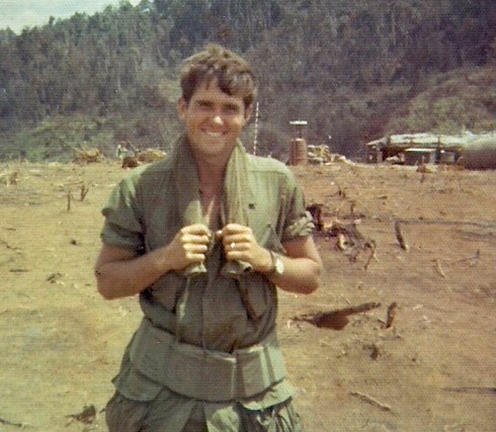
Sgt Randy Cox
Photo by Randy Cox
The following booklet is broken
down into three segments:
1) Excerpts from Letters written to my wife, Glenda: memories
associated with dates and supporting details.
2) Events, animals, etc
3) Miscellaneous entries: Rules of Engagement, Admiral Nimitz
WWII, Pictures
Excerpts from Letters written to my wife, Glenda: memories associated with dates and supporting details
Randy Cox D/1/8 Pleiku, AnKhe
FATE, BUDA, ALIENS, GOD- how did I survive? When you count the
number of near deaths, and/or actions mentioned in the following,
you can
only come to one conclusion God was watching over me. I know my
family prayed for me and I had a believe in God which did not
fully
development until later in my life. Having said that I know he
has a purpose for me and/or my family. If I had not returned; my
wife’s life would
have been altered and my son would not have been born. As you go
through the following, you can decide as to where my religious
beliefs are
derived from.
The following is an outline of my
year in Vietnam. First part is excerpts from the letters I wrote
home with a few notes concerning events which
I referred to in the letter. The second part is based on my
memories of events of that year. Part three is supporting
information.
I was attending college and working full time from 1966 to 1968
and starting to feel the pressure of trying to maintain this
life. I dropped out of
college making myself available for the draft. Glenda and I had
been engaged for 1 ½ years and we set the wedding date for
October 26, 1968
and on October 25, 1968 I received my draft notice.
Shortly after my wedding I
reported to Montgomery for processing prior to training. As we
lined up for our physical examination, I remember the
doctor walking down the line looking at each of the candidates
then stopping in front of me. He looked at my feet and asked if I
had any feet
problems. I did not and answer accordingly- NO SIR. Since, I have
flat feet I have surmise he was concern if I was fit for service
because of my
feet. Just think if I had said YES, I probably would have been
reclassified as 4F; not classified for service. If that had been
the case my life would
have been completely different. NO GI bill for college, working
at Avondale Mills until I was in my mid-fifties when they went
bankrupt, and my job
opportunities would have been limited because of age and living
in a town in which most of the citizens worked for Avondale.
After the examination, we reported
for 8 weeks of basic training at Fort Benning, Columbus, Ga, then
AIT for 8 weeks (Advance Infantry Training)
at Ft Polk, Louisiana. At the conclusion of AIT, I was given the
opportunity to go to OCS (officers candidate school) but I asked
the magic
question “Would I have to extend my time”. YES, four
years. NO, thank you. Then I was offered the opportunity to go to
NCO school
(Non-commissioned Officer) for 8 weeks at Fort Benning, Columbus,
Ga and I would not have to extend my time and upon completion I
would
become a buck Sargent an E5. They say never volunteer in the
Army, but I did in order to stay state side for 12 weeks for NCO
training and the
additional 12 weeks working as a Drill Instructor (DI) at Fort
McClellan, Anniston, Al. all prior to being shipped to Vietnam on
Oct 28, 1968 one
year after being drafted.
|
|
|
|
The NCO Problem . . . __ (Excerpts from a article by Jerry S. Horton, Ph.D See the full article here:
Charlie Co./2nd Bn/506th Inf./101st Airborne Div.
Tour of Duty: South Vietnam 1970-1971
As early as 1956
the Army officially knew it would not have enough NCO's for a
sustained war. A staff study asserted that in the future the need
for enlisted leaders would far exceed the number available and
that at the commencement of, and during hostilities, the need for
leaders might
be so pressing as to make it necessary to appoint leaders before
their ability could actually be proved on the battlefield.
It was also
recognized in Vietnam that it was not a senior commander's war,
it was a junior leader's war. There were over 200 combat
sergeants
turning over each week and many men were one tour enlistees or
inductees. The Army faced the problem of sending career men back
into
harm's way or filling NCO positions with unqualified men. The
demand for experienced NCO's in Vietnam far exceeded the supply.
In Vietnam
the Army was trying to meet these shortages by making a two-grade
substitution of personnel. This means the platoon leader in
combat is
forced to pick the brightest PFC he can find, declare him the
sergeant, and entrust the lives of a dozen men to his care. _________________
The Army had to do something different . .!! _And they did . .!!!
The Solution . . . The Non Commission Candidate Course (NCOC) at Ft. Benning GA _ (Infantry MOS's: 11B, 11C, 11F)
My training took
place at the NCO Academy at Fort Benning, Georgia. When I
graduated this time, I would have earned the rank of E-5, known
to everyone in the military as an instant NCO! An instant
Sergeant! A Shake & Bake Sergeant! _
Most career
noncommissioned officers rise through the ranks in the Army only
after years of service. The older NCO's resented us because we
would receive our stripes in school, and not in long-term service
or combat. Many of the enlisted men, whom we would command,
resented us
because we were inexperienced, and we might have taken their
opportunity for field promotion from them or get them killed
while we matured
on the job in combat. We were often treated with the same disdain
by commissioned officers, although their training had been very
similar to
ours.
When I, and many others like me,
went from an E-1 to an E-5 in only three months, we became a
brand-new Shake & Bake Sergeant. This
nickname was taken from the Betty Crocker quick-mix product for
baking chicken and had become very popular during the sixties. In
three short
months, the Army produced instant sergeants . . . Shake &
Bake NCO's.
The NCOC Handbook
The NCOC training program was a
very demanding 12 week course with a high percentage of
candidates washed-out during the course period.
The last two months of our training was identical to that given
to OCS officer candidates. Our technical and theory classes took
place in the same
classrooms of the Infantry School, and we were trained on the
same field ranges by the same instructors. During this period the
harassment and
discipline continued, but the Army's goal was not to attempt to
break us, but as to weed out those who were deemed unable to
become capable
leaders. The Army wanted only the best to finish the program.
They needed us in Vietnam....
The Vietnam War Experience of Shake & Bake's. . .
Experience in
Vietnam History shows that the Shake & Bake Sergeants
performed well in combat. They served with distinction as leaders
in our
infantry units. They suffered high casualty rates in combat
because they were assigned to units that experienced heavy
fighting. There were
1,003 Shake & Bakes killed in combat out of 20,068 men
trained. This casualty rate, at five percent, was considered to
be extremely high. I had
no idea that I was pursuing one of the Army's most dangerous
careers, but we were invented for only one purpose - to lead men
in combat.
And we performed that job well!! _
There were three Medal of Honor recipients that graduated as NCOCs.
It turned out that the last Shake & Bake Sergeant graduated from Fort Benning on March 18, 1972. The Army concluded that the program was a success. Because of it the Army implemented two new, similar programs. These programs gave new opportunities for advancement to career soldiers returning from Vietnam. The new schools established at Fort Benning were BNCOC (Basic NCOC) and ANCOC (Advanced NCOC). The Shake & Bake program was the basis for all training of NCO's in today's Army.
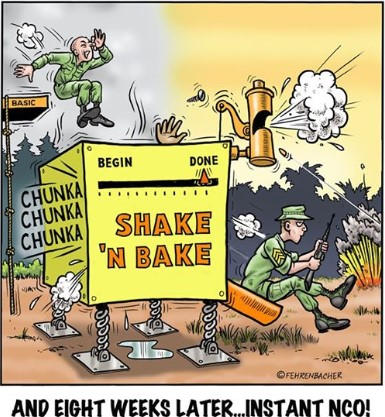
This extra schooling kept me in the states until Oct, 28 1969, This meant I missed the part of the TET Offensive which is explained in the following:

Tet Offensive, attacks staged by
North Vietnamese forces beginning in the early hours of January
31, 1968, during the Vietnam War. The Tet
Offensive consisted of simultaneous attacks by some 85,000 troops
under the direction of the North Vietnamese government. The
attacks were
carried out against five major South Vietnamese cities, dozens of
military installations, and scores of towns and villages
throughout South Vietnam.
The offensive derives its name from the Vietnamese New Year
holiday, during which the attacks occurred.
By mid-February, or two weeks into
the offensive, Washington was estimating that enemy casualties
had risen to almost 39,000, including 33,249
killed. Allied casualties were placed at 3,470 dead, one-third of
them Americans, and 12,062 wounded, almost half of them
Americans.

Date
Phase 1: January 30 – March
28, 1968
Phase 2: May 5 – June 15, 1968
Phase 3: August 9 – September 23, 1968
Location South
Vietnam
11°N 107°ECoordinates: 11°N 107°E
Result
South Vietnamese-American tactical
victory;[1] North Vietnamese
propaganda, political and strategic victory[2]
• Heavy casualties on both sides[3][4]
• North Vietnamese invasion repulsed[1]
• Depletion of Viet Cong leading to the use of greater North
Vietnamese manpower
The Ho Chi Minh Trail was a complex web of different jungle paths
that enabled communist troops to travel from North Vietnam to
areas close to
Saigon. It has been estimated that the National Liberation Front
received sixty tons of aid per day from this route. Most of this
was carried by
porters. Occasionally bicycles and ponies would also be used.
At regular intervals along the
route, the NLF built base camps. As well as providing a place for
them to rest, the base camps provided medical
treatment for those who had been injured or had fallen ill on the
journey. In the early days of the war, it took six months to
travel from North
Vietnam to Saigon on the Ho Chi Minh Trail. But the more people
who traveled along the route, the easier it became. By 1970, fit
and experienced
soldiers could make the journey in six weeks. From the air, the
Ho Chi Minh Trail was impossible to identify and although the
United States Air
Force tried to destroy this vital supply line by heavy bombing,
they were unable to stop the constant flow of men and supplies.
The main danger to
the people who traveled on the Ho Chi Minh Trail was not American
bombs but diseases like malaria. In the early days, as many as 10
per cent of
the porters traveling down the trail died of disease.
The North Vietnamese also used the
Ho Chi Minh Trail to send soldiers to the south. At times, as
many as 20,000 soldiers a month came from
Hanoi in this way. To stop this traffic, it was suggested that a
barrier of barbed wire and minefields called the McNamara Line
should be built. This
plan was abandoned in 1967 after repeated attacks by the NLF on
those involved in constructing this barrier.
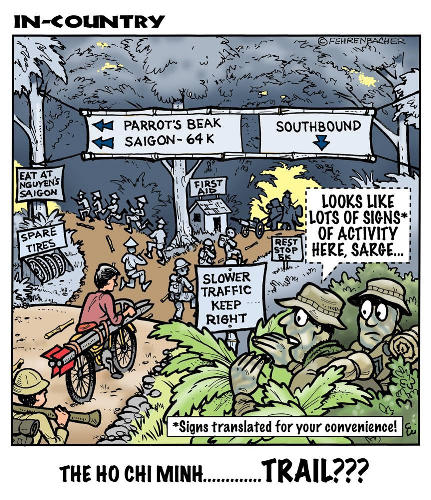

D/1/8 Pleiku, AnKhe
Letter reprint from the LT
Oct 19, 1969 LZ Pat---Expect 2nd
& 3rd platoons back tomorrow with 1st on 15-minute standby.
Required daily rations of Dapsone visually
verified by squad leaders and once a week rations for
Chloraquine-Primaquine visual verified by platoon leaders . Also
by Sunday a report on
protective masks and steel pots needed. Daily by 07:00 weapons
cleanliness status report. Briefed RTO on my radio policies. Put
out word about
grenades double pinned, taped & in pouches. Got in Beer &
Soda today 56 cases. Finally got my rucksack. In about 3 or 4
days I will be moving
Delta to take up road security along QL19 (14) from AnKhe to the
Mang Yang Pass. Around the 1st of the month we are going to move
the entire
Bn. to Bong Song, 30 Kilo's North of AnKhe, near the coast. It's
still raining off and on, so things get bad every now and then,
but no enemy action
yet.
----------------------------------------------------------------------------------------------------
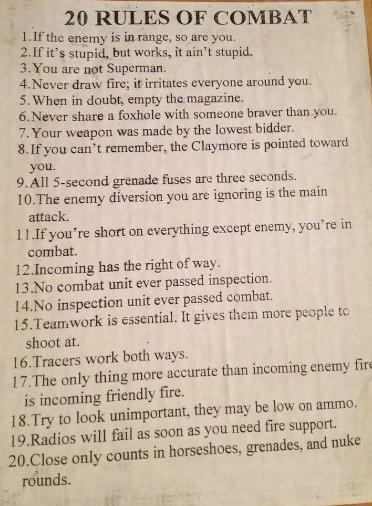
Oct 30, 1969
This is the beginning of my trip
to Vietnam. The flight was uneventful, but it did give us an
opportunity to view the county side from 30,000 feet
-Rocky Mountains, Grand Canyon, etc. Before traveling overseas,
we were stationed in the Northwestern US for processing, I think
it was
Washington. We were restricted to a large building upon arrival,
but that afternoon three NCO’s walked us to the NCO club for
a couple of drinks.
Oct 31, 1969
They woke us up at 4:30 am. Rumor
has it 70 of the 83 of us will be flying out on stand-by. Several
people asked about getting stand-by status
wanting to go to avoid the wait. Since I did not catch that
flight, I was able to go the to the PX to send my wife, Glenda, a
set of earrings as a
present. I believe it was an anniversary present since the 26th
was our FIRST Anniversary.
Nov 1, 1969
1:00 pm and I am still waiting on
my flight. All we had do for entertainment is play pin ball,
watch tv or lay in our bed. As an afterthought I wished I
had bought a book at the PX to help keep me occupied. Several
times a day we would police around the building, it was to insure
we stayed busy
and not get in trouble. Policing consists of walking in a picket
line picking up any trash laying on the ground- cigarette butts,
gum wrappers, etc.
Naturally, there would be little because of prior policing
duties.
Nov 2, 1969
During our flight, we stopped at
Anchorage, Alaska for a meal and to refuel the plane for the
7-hour flight to Japan. At Anchorage, the temperature
was 38 degrees, wind blowing and snow falling, and we were in
warm weather clothing(khakis). We off loaded the plane and ran to
the PX to stock
up on a few items for the flight. As we walked around the PX, we
were we shocked at the expense of items on the shelves.
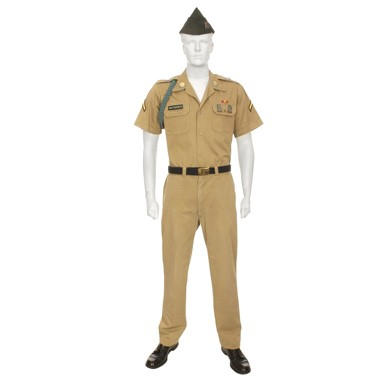
Nov 3, 1969
We left Tokyo for the 5 ½ hour
flight to Bien Hoa, Vietnam. I was amazed at the size of Tokyo
based upon the length of the flight over the city
lights. The discussion on the plane was around President
Nixon’s speech on Nov 3, 1969. After crossing the
international day line, we realized we
had lost a day. We arrived at 8:00 am and were transported by
convoy to Long Binh. The weather is like Alabama-hot, humid,
currently with a little
wind but the smell is different. As we off loaded, we passed
soldiers heading to our plane as it was being refueled. It was a
solemn sight to see the
expression between the two groups. Ours being an apprehension of
what lay before us and the Vets had a mixture of facial
expression from joy to
gloom depending upon their function in country. Some with plush
jobs, luxuries, and benefits which they did not want to leave.
|
|
|
|
|
|
I mentioned the smell because it
seemed everyone had BO. It was awful. Being fresh from the states
and having normal hygiene for most of my life,
playing football, hunting, going through basic and AIT in the
military I developed an odor, but I had the ability to clean up
after a couple of days. I
had never smelled body odor that strong. That is one factor,
which came in to play as I patrolled Viet Nam. The
Vietnamese’s body odor was
different from ours’s because of the foods they ate which
meant their human waste deposited around the area had a distinct
odor. We and they
walked around Viet Nam looking and smelling for each other and I
am certain we were both were thankful our encounters were
limited.
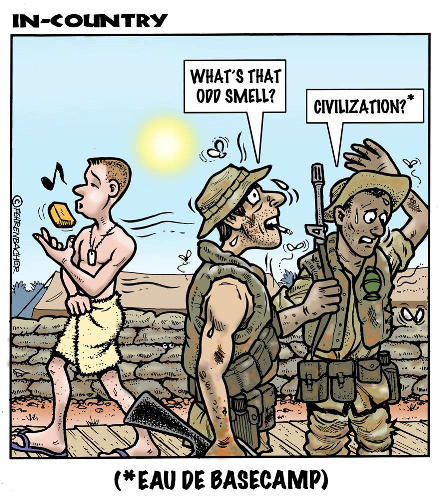
In addition to the BO and other
strange smells, add the smell of human waste and diesel fuel
being burnt to the atmosphere. The outhouse is just like
you would think but without a hole in the ground. There was a
bottom third of a 55-gallon drum positioned to catch the waste.
They had latrines
built with the lower quarter of a 55-gallon drum below the seat
to catch the urine and waste. This waste would have to be
disposed of and the
common method was for two mamasan (older Vietnamese ladies) to
put the container on a long pole between the two of them carry it
to a safe
location; mix the waste with fuel then set it on fire if the duty
was not assigned to a soldier. By the sheer number of military
personnel on base camp,
you can image the number of the containers which are being burnt
each day, so it was a constant smell you got accustomed to after
a couple of
days. This duty could be performed by soldiers by dragging the
drum out a safe distance from the wooden outhouse to perform the
routine
mentioned above if the duties were not assigned to the locals.
|
|
I did not get this duty but at
times my men had to perform this duty. The outhouse was a luxury
while on a firebase. In the field, you can guess
what was required except we had TP. One pack per meal
(c-rations). My brother-in-law was in Korea and his method was to
fold the TP into a
square tearing off the corner (save that portion). After you
finish your job, you poke your finger through the hold and clean
yourself. The small
portion you saved was to clean your fingernail (joke).
C Rations |
Tissue |
|
|
|
|
I went to the snack bar for a bite
to eat and played the nickel slot machine winning $2.00. Because
of the flight and time changes I fell asleep
around 5:00 pm and slept until 4:00 am ready to start work
details. Small world I found someone from my hometown, Sylacauga,
this was
his third tour in Vietnam.


Disclaimer and Copyright Notice:
All images attributed to Randy Cox are copyright © Randall D. Cox 2022.
All "In Country" cartoons are from the In Country Facebook page and are copyright © Phil Fehrenbacher.
All images not attributed to
Randy Cox used in the presentation are done so under the Fair Use
doctrine,
and are not intended as infringement upon the copyright of the
original owner or creator of the image.
They are used here by Randy for non-profit educational purposes,
to help illustrate his story.
If you are the owner of an image
used in the presentation for which there is no credit given,
please contact the website
at c22inf@cox.net so we may credit you as the source, or remove the
image, according to your wishes.
Home | Photos | Battles & History | Current |
Rosters & Reports | Medal of Honor | Killed
in Action |
Personnel Locator | Commanders | Station
List | Campaigns |
Honors | Insignia & Memorabilia | 4-42
Artillery | Taps |
What's New | Editorial | Links |